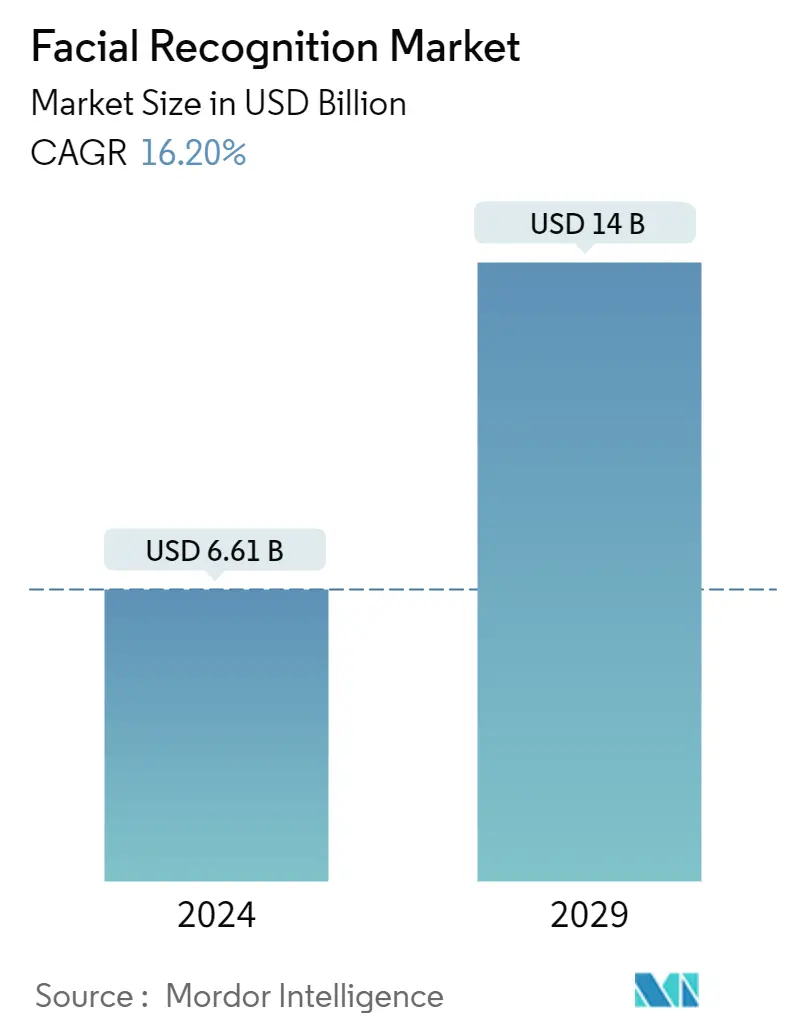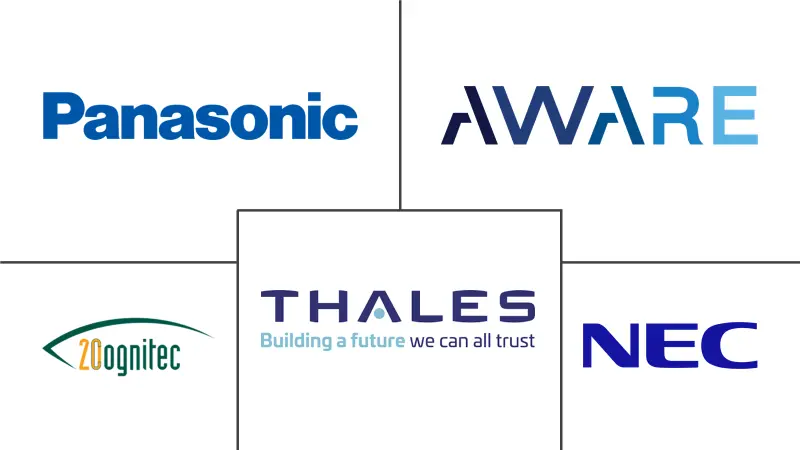Market Size of Facial Recognition Industry

| Study Period | 2019 - 2029 |
| Market Size (2024) | USD 6.61 Billion |
| Market Size (2029) | USD 14 Billion |
| CAGR (2024 - 2029) | 16.20 % |
| Fastest Growing Market | Asia Pacific |
| Largest Market | North America |
Major Players
*Disclaimer: Major Players sorted in no particular order |
Facial Recognition Market Analysis
The Facial Recognition Market size is estimated at USD 6.61 billion in 2024, and is expected to reach USD 14 billion by 2029, growing at a CAGR of 16.20% during the forecast period (2024-2029).
Facial recognition refers to the way of identifying or confirming an individual's identity using their face. Facial recognition systems can be utilized to identify people in photos, videos, or in real time.
- Rising criminal activities worldwide have resulted in the increasing installation of surveillance systems across all verticals. For instance, according to the Council on Criminal Justice, thefts and robberies in major cities across the United States increased by around 20% in the first half of 2022. Integrating facial recognition in security systems can significantly enhance the effectiveness of security and surveillance across sectors and reduce overall costs.
- The market is witnessing various developments from private and public organizations, further boosting market growth. For instance, in August 2022, DRDO (Defence Research and Development Organization) developed an advanced Facial Recognition Technology (FRT) to increase surveillance. The DRDO has developed FRSD to solve the issue of facial recognition in the wild, where there are wide-ranging issues like low-resolution cameras.
- Government initiatives are expected to contribute to the significant growth of such technologies. For instance, As of July 2022, the CBP had deployed facial recognition technology to 32 airports for travelers leaving the U.S. and all airports for travelers entering the country.
- With the outbreak of the pandemic, facial recognition systems were adopted for wider use as they were used to track COVID-positive people who needed to stay home. Moreover, since the outbreak of COVID-19, facial recognition software vendors have upgraded their algorithms with new features, such as recognizing faces with a mask on.
- However, data breaches involving facial recognition data increase the potential for identity theft, stalking, and harassment as, unlike passwords and credit card information, faces cannot easily be changed. Such factors may hinder the market growth.
Facial Recognition Industry Segmentation
Facial recognition is a biometric software capable of uniquely identifying, recognizing, and authenticating a person by comparing and analyzing patterns based on the facial contours of the subject. The report in consideration deals with facial recognition software in line with technologies like 3D, 2D facial recognition, and facial analytics. The study under consideration provides applications, market trends, influencing factors, and growth data of the software by end-users, such as security and law enforcement, healthcare, retail, and other end users.
The facial recognition market is segmented by technology (2d facial recognition, 3d facial recognition, and facial analytics), application (access control, security and surveillance, and other applications), end user (security and law enforcement, healthcare, retail and e-commerce, BFSI, automobile and transportation, telecom and it, media and entertainment, and other end users), and geography (North America, Europe, Asia-Pacific, Latin America, and Middle East and Africa). The market sizes and forecasts are provided in terms of value (USD) for all the above segments.
| By Technology | |
| 3D Facial Recognition | |
| 2D Facial Recognition | |
| Facial Analytics |
| By Application | |
| Access Control | |
| Security and Surveillance | |
| Other Applications |
| By End User | |
| Security and Law Enforcement | |
| Healthcare | |
| Retail and E-commerce | |
| BFSI | |
| Automobile and Transportation | |
| Telecom and IT | |
| Media and Entertainment | |
| Other End Users |
| By Geography | |
| North America | |
| Europe | |
| Asia-Pacific | |
| Latin America | |
| Middle East and Africa |
Facial Recognition Market Size Summary
The facial recognition market is poised for significant expansion, driven by its increasing integration into security and surveillance systems across various sectors. The technology, which identifies or confirms an individual's identity using their facial features, is becoming essential in enhancing security measures and reducing costs. The rise in criminal activities has led to a surge in the installation of surveillance systems, with facial recognition technology playing a crucial role in improving their effectiveness. Developments from both private and public organizations, such as advanced facial recognition technologies and government initiatives, are further propelling market growth. The COVID-19 pandemic has also accelerated the adoption of facial recognition systems, as they were utilized for tracking and monitoring purposes, leading to advancements in algorithms capable of recognizing masked faces. However, concerns over data breaches and potential misuse of facial recognition data pose challenges to market growth.
In the retail sector, facial recognition technology is gaining traction as it offers opportunities to enhance customer experiences and improve security. The technology enables retailers to analyze customer moods and facial expressions, personalize shopping experiences, and prevent theft. The demand for cameras equipped with facial recognition technology is expected to rise, driven by the need for enhanced consumer insights and security. The Asia-Pacific region, particularly India and China, is witnessing substantial growth in the adoption of facial recognition technology due to technological advancements and expanding retail sectors. The market is moderately competitive, with major players like NEC Corporation and Panasonic Corporation leading the way, while collaborations and innovations continue to shape the industry's landscape.
Facial Recognition Market Size - Table of Contents
-
1. MARKET INSIGHTS
-
1.1 Market Overview
-
1.2 Industry Attractiveness - Porter's Five Forces Analysis
-
1.2.1 Bargaining Power of Suppliers
-
1.2.2 Bargaining Power of Buyers
-
1.2.3 Threat of New Entrants
-
1.2.4 Threat of Substitute Products
-
1.2.5 Intensity of Competitive Rivalry
-
-
1.3 Industry Value Chain Analysis
-
1.4 Assessment of COVID-19 Impact on the Industry
-
1.5 Technology Snapshot
-
-
2. MARKET SEGMENTATION
-
2.1 By Technology
-
2.1.1 3D Facial Recognition
-
2.1.2 2D Facial Recognition
-
2.1.3 Facial Analytics
-
-
2.2 By Application
-
2.2.1 Access Control
-
2.2.2 Security and Surveillance
-
2.2.3 Other Applications
-
-
2.3 By End User
-
2.3.1 Security and Law Enforcement
-
2.3.2 Healthcare
-
2.3.3 Retail and E-commerce
-
2.3.4 BFSI
-
2.3.5 Automobile and Transportation
-
2.3.6 Telecom and IT
-
2.3.7 Media and Entertainment
-
2.3.8 Other End Users
-
-
2.4 By Geography
-
2.4.1 North America
-
2.4.2 Europe
-
2.4.3 Asia-Pacific
-
2.4.4 Latin America
-
2.4.5 Middle East and Africa
-
-
Facial Recognition Market Size FAQs
How big is the Facial Recognition Market?
The Facial Recognition Market size is expected to reach USD 6.61 billion in 2024 and grow at a CAGR of 16.20% to reach USD 14 billion by 2029.
What is the current Facial Recognition Market size?
In 2024, the Facial Recognition Market size is expected to reach USD 6.61 billion.

